
Wiesner, David. (2001).
The Three Pigs. New York, New York: Houghton Mifflin Company.
Taking
The Three Pigs to new heights and new places, this unpredictable retelling of the classic story will delight children's imaginations. The three brothers wander from the own story, admittedly leaving the wolf a little baffled, and pick up eccentric characters from different tales. '
Connecting to the Standards
Grade 2 RL (9): Compare and contrast two or more versions
of the same story (e.g., Cinderella stories) by
different authors or from different cultures.
- This story provides students with a different version of the familiar story, The Three Little Pigs.
Grade 2 W (3): Write narratives in which they recount a
well-elaborated event or short sequence of
events, include details to describe actions,
thoughts, and feelings, use temporal words
to signal event order, and provide a sense of
closure.
- Students will do a creative writing exercise using the same conventions in The Three Pigs, but will have the chance to use the characters in their favorite books to tell the story.
Grade 2 L (2): Demonstrate command of the conventions of
standard English capitalization, punctuation,
and spelling when writing.
- Students will write their own narrative and will demonstrate mastery over these conventions through their writing.
Learning Outcomes
From this reading and subsequent activity, students will gain an understanding of comparing and contrasting two similar stories. Over the course of the year, students will continue to read different versions of familiar and similar stories. Students will then use this understanding of differing stories to write a narrative based off a story they are familiar with, using similar storytelling devices to The Three Pigs. Through the writing of this narrative, students will demonstrate their command over writing conventions including "capitalization, punctuation, and spelling..."
The final product, the written narrative, plus any previous rough drafts will be used to show progress towards the standards. Students will have multiple chances to revise and edit their narrative as they work their way through the writing process.
Adapted to the Classroom
Before reading The Three Pigs by David Wiesner, the class will participate in reading other versions of the The Three Little Pigs. Prior to that, it may be a good idea to also introduce other tales and different versions of them to get students used to the idea that storytelling is an art and a story may change based off of who is presenting the story.
Once the book is read, in a teacher-guided read aloud, students will have the chance to discuss the differences in this version of the story to past versions. This discussion will be mostly student-led, but the teacher will most likely need to guide the discussion if it becomes stagnant. Once students have an understanding of the storytelling devices used in The Three Pigs, they will have a chance to go to the library to pick out a book they are familiar with or want to become familiar with. The teacher should also provide more books for students to use who are having trouble deciding what story to use.
Students will then engage in a creative writing exercise that will most likely span over 4-5 days. Students will start with a rough draft of their favorite story, that should follow the devices used in The Three Pigs, such as characters escaping the story, duping the main villain in clever ways, or meeting characters from other stories along the way. Over the course of the next few days, students will have time to revise and edit their stories until they are left with a final draft that they submit. It would be fun for the teacher to put these stories into a classroom collection, either in book form or online for parents to view.
Bloom's Taxonomy
Who are the main characters in your narrative? (Knowledge)
What differences exist between the original story and this retelling? (Comprehension)
How would you create a new ending for your story? (Synthesis)
What might happen if you combined this story with this other one? (Synthesis)
Differentiation
Because this project involves a lot of reading and writing, the main concern would be with students with disabilities that affect their ability to read and write such as students with dyslexia. Additional support should be provided to these students and possibly include one-on-one sessions with these students to check their progress. Additional supports could be put in place to make sure they succeed such as having a dictionary nearby for students to refer to (this could be done for any student) or having technology that is meant to support students with dyslexia or other language disorders.
 Who does not love leaving at 4:00am to drive to spend weeks on end with your relatives. Through this text you will see how daily life changes when the relatives come to town. You will also see traditions that only happen when the relatives come to visit.
Who does not love leaving at 4:00am to drive to spend weeks on end with your relatives. Through this text you will see how daily life changes when the relatives come to town. You will also see traditions that only happen when the relatives come to visit. 







